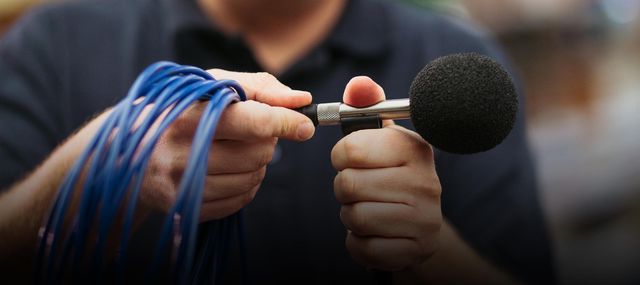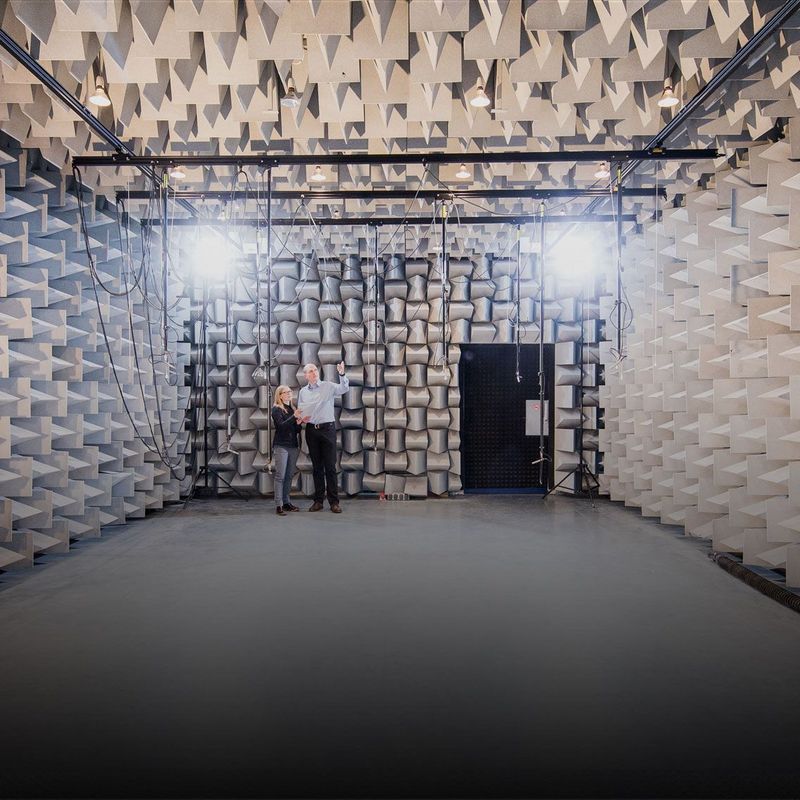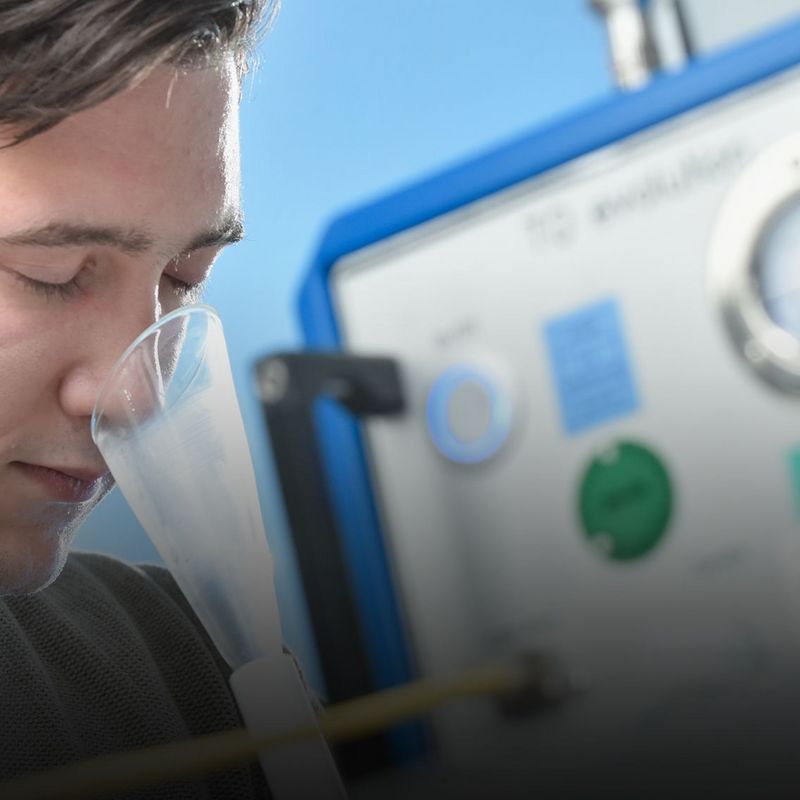15 November 2018
Factories, windmills and festivals generate goods, power and entertainment - and always make noise in the process. To avoid driving local residents to distraction, legal limits for noise emissions must be adhered to. And it’s down to noise experts like Ingo Tzschacksch to ensure compliance. #explore was present at the measurements taken on the “Wandsbeker Wiesn” in Hamburg.
The tripod has already been set up facing the magnificent alpine panorama. Ingo Tzschacksch is now busy unpacking the remaining equipment. However, he has no interest in taking shots of the blue mountains painted on a wooden backdrop. The TÜV NORD expert is concerned with not what he can see but what he can hear in the marquee on the Wandsbeker Wiesn.
Before the largest Oktoberfest in Hamburg can be ritually opened with the tapping of the first keg, Tzschacksch must first give the nod. This is because anyone who wants to hold events like this in a public space must first satisfy a number of requirements for such “special use”. To prevent a scenario in which local residents are forced from their beds in the middle of the night by overly loud music, noise emissions must not exceed certain threshold values. And Tzschacksch is on hand to ensure that the locals do not miss out on this “right to protection”.
© Selim SudheimerA party mood without ill effects: To ensure that the music in the marquee doesn’t drive the neighbours from their beds, noise control experts check in advance whether the statutory noise limits are being observed.
As a noise expert, his job is to check whether industrial plants, factories, sports events or festivals like the Oktoberfest are louder than the law permits. And the limits vary depending on the location and time of day. In industrial areas, noise emissions may not exceed 70 dB(A) either day or night; in purely residential areas, the maximum permitted value is 50 dB(A) during the day and 35 at night. In exceptional circumstances, such as those that pertain to temporary special events like street parties or, in this case, the Oktoberfest, the daytime limit is increased to 70 dB(A), with noise emissions of up to 55 dB(A) permitted during the night. Just by way of comparison, a vacuum cleaner will generate up to 75 decibels, and the figure for a TV or radio played at normal volume in a dwelling will be 60 dB(A).
Pink noise in the marquee
Before the measurements can start, Tzschacksch must first calibrate the meter. “In the class 1 measuring device we’re using here, the measurement deviation is less than 1 dB, which is very low,” the expert explains. He then screws the preamp to the microphone capsule, sets up a wind ball in front and wires up the microphone and the measuring device - and then it’s down to the sound engineer to rig up the system. Anyone who happens to have their hands free at this point sticks their fingers in their ears. The noise that blares out of the speakers is vaguely reminiscent of a jet engine starting up.
Technically speaking, we’re currently hearing pink noise, explains Stefan Goers from TÜV NORD, who is assisting with the measurements: “Pink noise is a frequency spectrum defined by the relevant standard as a test signal in which the average person experiences all the frequency ranges of the audible sound spectrum as equally loud.” This ‘pink noise’ is used to check how the noise from the emissions source - the sound system of the Oktoberfest - spreads to what is referred to as the place of immission - the windows of the local residents. Ingo Tzschacksch can then calculate how the level of the sound system needs to be set to ensure that the limit is not exceeded.
© Selim SudheimerLet's get loud: In his quest to make things as quiet as possible for the local residents, things can in the first instance get pretty loud for Ingo Tzschacksch when he’s at work.
Doing this involves heading out onto the street with a further microphone. The sky is grey over Marktstrasse in Wandsbek. Rain is forecast for lunchtime, but the weather is currently still playing ball. This is a good thing, because heavy rain and strong wind render measurement results unusable, Tzschacksch explains as he sets up the microphone tripod on the shopping street. The mic is set up at a height of five metres, the same as the first-floor windows. After all, the whole point is to find out what level of noise is experienced when the windows are open.
So it is, of course, no coincidence that he has chosen to set his microphone up here. Before Tzschacksch heads out for his appointment with the neighbourhood, he uses plans provided by the operators and local maps to get a clear picture of the situation. “Where is the sound system, in which direction is the sound going to be emitted, where do the people live who have a right to protection?” explains the expert. He then models the district on his computer to enable him to predict how the sound will spread, in front of which apartments the limit is most likely to be exceeded, and, accordingly, where he needs to set up his measuring equipment. He sometimes uses Virtual Reality goggles at his computer in a virtual simulation of the situation so that he can plan yet more accurately.
Waiting for the next red light
“We then have 20 seconds in each case to collect an exact reading,” explains Tzschacksch. The measurements are taken in step with the traffic lights, at a point when the traffic noise abates a little. The traffic light turns red, and Tzschacksch starts the measuring process. It’s then a matter of being quiet and hoping that the measurement won’t be disrupted by crying children or passers-by with loudly tapping heels. “That's a pretty big bicycle there on the cycle path!” Tzschacksch comments sarcastically as a stray Harley-Davidson roars through the recording zone. Humour and patience are qualities that an expert in this field really needs.
© Selim SudheimerFirmly set: once the limiter has been set and the system sealed, even the most effusive of DJs can no longer turn up the music louder than the statutory limit.
A few green-to-red phases later, Tzschacksch nods in satisfaction. The measurement adds up. Now, having established the degree of transmission - the difference between the noise level on the stage and in front of the windows of the local residents - it’s time to head back into the marquee. Here, the limiter is set to the maximum allowable value outside the marquee. The expert then seals the system. If the DJ should later get carried away by the party mood and jack the system up too far, the limiter will turn it back down again immediately so that, in reality, only 70 dB(A) escapes into the environment. This is because what is known as the dB(A) scale is created during the sound measurements.
Based on human hearing
“With this scale the frequencies are so weighted as to correspond to the human sense of hearing,” explains Stefan Goers. And because some noises bother us more than others, the sound experts don’t just base their work on the measurement value but also take other factors into account. These include the impulsiveness of a noise, such as, for example, booming bass, which drives up the noise level at short, repeated intervals. “In point of fact, music is always impulsive,” says Ingo Tzschacksch. “Experience indicates that we’re dealing here with an impulsiveness of 3 to 4 dB. "And we take this into account when we set the level by amending the measurement results accordingly.”
© Selim SudheimerMeasuring is only half the battle: the engineers then have to meticulously document what is being measured, how and under what conditions.
The music system in the marquee is thus set at a slightly quieter level than the measurements suggest. Also taken into account by the experts in the form of additional restrictions is what is known as tonality - for instance, screeching electric guitars that shred the nerves of local residents. At sporting events, concerts and festivals, the amount of information is also a factor, Tzschacksch explains. “Information content relates to comprehensibility - in other words, information that I don’t want and which disturbs me as a result.” After all, while Celine Dion fans might enjoy hearing “My heart will go on” wash over them at the kind of volume at which you might sing along, a Metallica devotee might find the same thing bothersome.
Fine adjustments with Peter Fox
To check whether the settings are right, the experts head back out into the street for some control measurements. This time, the test involves the playing of the kind of music typical of the Oktoberfest. “You’re good to go,” says Ingo Tzschacksch to the organiser of the Oktoberfest, who is standing next to him with a walkie-talkie. “I'd like to see 70 dB(A).” - “Nico, turn the music up to 70 dB(A), please,” radios the Oktoberfest boss to her sound technician inside the marquee. Whereupon the song “Alles neu” by German reggae and hip-hop musician Peter Fox echoes out over Marktstrasse, at a level that is still too loud. “Is a door open?” asks the noise control expert. “Nico, are all the doors closed?” asks the organiser via her walkie-talkie. One moment later, the music gets noticeably quieter. “We’re good now,” says Tzschacksch, satisfied. “But we’ll take a few more measurements, just to be on the safe side.”
© Selim SudheimerAiming high: In order to get as close as possible to the windows of the local residents, the noise assessors work with extra-large tripods.
Claudiusstrasse, also within earshot of the marquee, is a short hop away. “First measurement - got it, there’s your value. Great!” says Ingo Tzschacksch and laughs. What can’t be measured, however, is the night-time value. But the noise expert has already worked this out. The music from the marquee is drowned out by the traffic noise generated on the Markstrasse. “The traffic noise - at least during the day - is round about the required 55 dB(A) in the night. Until the event shuts down at either 10 pm or midnight, this won’t tail off to any noticeable extent.” To document the loud ambient noise for the district office, Tzschacksch then takes a measurement without music. As far as he’s concerned, there are now no further obstacles to the opening of the Oktoberfest in Wandsbek.
Noise measurement at dizzying heights
The engineer also monitors adherence to the limit values at techno concerts or motor races. But he’s mostly deployed at industrial plants of all kinds. After all, noise emissions from such installations can be an ongoing source of nuisance for local residents. And what makes the job so exciting for Ingo Tzschacksch is this: He works every day in places which most people only get to see on open days. “You name it - aircraft manufacturers, food producers, coffee roasters, car factories - there’s nowhere we don’t go. And that makes our work really varied and interesting.” When he’s on site he also advises plant operators on how to run their machinery more quietly as a way of protecting the ears of the local residents and their own staff.
He often gets closer to plants than most people would dare to go, scrambling about up 60-metre chimneys, for example, to measure the noise issuing from the aperture. Or crawling on his belly into the hub of a hundred-metre wind turbine to find out why the maintenance engineers often find it overly loud when they have to do up the bolts. Ingo Tzschacksch brings more peace into people’s lives - in the truest sense of the word.










